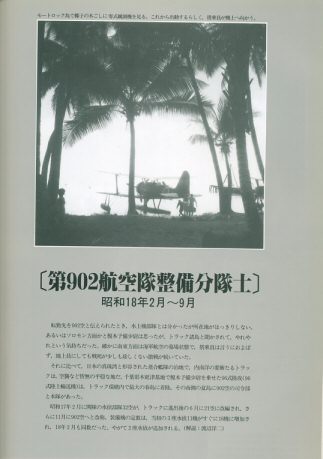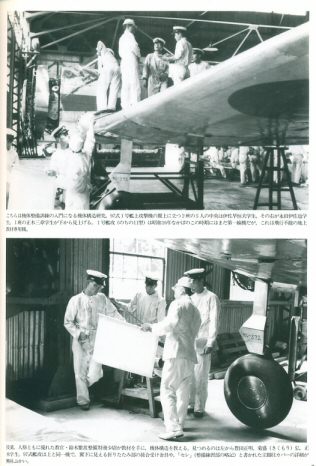One of the less known but invaluable Japanese aviation publications is Koku Fan Illustrated #109 "Umiwashi to Tomoni" (Together with the Sea Eagles), published by Bunrindo 2000.
The volume features photos from the collection of Enomoto Satoshi, an IJNAF ground crew member and the chapters are:
1. Pupils of the Mainetnance School in Yokosuka. 35 photos some featuring Nakajima E8N "Dave" and Nakajima B5N "Kate".
2. Aircraft Carrier Hiryu. Including memories and the diary of Enomoto-san when he served with Hiryu.
3. Artwork. eight pages of beautiful artwork created by Enomoto-san.
4. Mie Kokutai. Where Enomoto-san served as an instructor; 11 photos.
5. 902 Kokutai. 28 photos taken in Truk including some of Mitsubishi F1M, Aichi E13A and some rare Kawanishi H6K cockpit shots.
6. Opama Kokutai. 10 photos.
7. Recconnaisance 11 Hikotai. 32 photos of Nakajima C6N1 "Saiun" including some taken from inside the cockpit.
8. Azusa Special Attack Unit. Nine photos of Yokosuka P1Y "Ginga".
9. Dai 1 Kamikaze Ohka Tokubetsu Kogekitai (1 Kamikaze "Ohka" Special Attack Unit). 13 photos of Mitsubishi G4M "Betty".
10. End of the War. 11 photos taken in Oita, Hiroshima, Kure and Tokyo.
All the photos are of the highest quality, clear and very helpful to modelers and historians alike. The publication is very highly recommended. It has been a while since we last saw such amazing books from Bunrindo.
The publication is out-of-print. All our copies are now sold out but we hope to have more in the future.
Some observations on the great photos of Saiuns of 11th Recon Hikotai in this book:
Pages 106-109 show 762-13 with 762-20 parked to its left. #20 has the top surfaces of its fuel tank painted in a dark color, presumably the very dark topside green Saiun used or something close to match it, that perfectly bisects the tank - basically the same way a lot of FM-2 Wildcat drop tanks were painted. Very unusual for a JNAF plane but I'll bet someone noticed that this overlarge tank spoiled the airplane's camouflage from above. This is most obvious in a shot of #20 on page 113 - studying all these photos, no way it's a shadow. (Both 13 and 20 are also seen with Rising Sun flags (of different designs) on their antenna masts on pp. 9-10).
Two other small items might be explained in the captions somewhere - I hope so, George. The rear tip of the tank on 762-13 is clearly painted a dark color, possibly an identifying device for other aircraft, who knows.
752-50 on p.119 has a very small triangle design just below the aircraft numeral on the cowling. Directly behind that, and right above that assymetrical airscoop,is a really tiny marking that is mystifying to me: what appear to be two letters, a line below them, and two more below. Looks like FS over RP?...KV?...hard to read both, but especailly the lower one. The number 50 also appears on the front tip of its fuel tank, and looks red - at least it's lighter in color than the stains below it. Note that this airplane also bears a maintenence stencil *underneath* the airscoop, the same kind of marking often seen on the lower cowlings of Vals, Kates, and Zeros. All these aircraft look so cleanly painted and maintained. These photos are priceless and while I bought the book on the basis of the Saiun material, all the other sections show similar small touches in markings that are invaluable to modelers.
Thanks for any possible translation help, George.
Mark Smith
Correct Mark on all observations. Unfortunately the captions don't mention anything about the drop tanks or the cowling markings. Only in FAOW#108, on p. 48-49 Akimoto-sensei notices the darker markings on the drop tank of 752-13 and speculates that they are there to differentiate this particular drop tank from the others.
Nothing is mentioned on the cowling markings which are very difficult to make out but during our research for the A6M2-K (Zero-Trainer), featured on issue #6 of our magazine, we found that these markings were applied by ground crew members to show which crew team was assigned to each aircraft and as "technical notes" indicating the type of gasoline etc. On p. 74 of FAOW#33 there is a photo of a "Val" belonging to the Nagoya Ku with the marking "87丙" (87Hei) on the cowling side. But nothing is mentioned in the caption.



I certainly agree - this is a very special book in terms of its photo quality, and covers types poorly served by "the same old pictures" over the years. Nice to have some background in English about where they came from, thanks, George.
ReplyDeleteSome observations on the great photos of Saiuns of 11th Recon Hikotai in this book:
ReplyDeletePages 106-109 show 762-13 with 762-20 parked to its left. #20 has the top surfaces of its fuel tank painted in a dark color, presumably the very dark topside green Saiun used or something close to match it, that perfectly bisects the tank - basically the same way a lot of FM-2 Wildcat drop tanks were painted. Very unusual f or a JNAF plane but I'll bet someone noticed that this overlarge tank spoiled the airplane's camouflage from above. This is most obvious in a shot of #20 on page 113 - studying all these photos, no way it's a shadow. (Both 13 and 20 are also seen with Rising Sun flags (of different designs) on their antenna masts on pp. 9-10).
Two other small items might be explained in the captions somewhere - I hope so, George. The rear tip of the tank on 762-13 is clearly painted a dark color, possibly an identifying device for other aircraft, who knows.
752-50 on p.119 has a very small triangle design just below the aircraft numeral on the cowling. Directly behind that, and right above that assymetrical airscoop,is a really tiny marking that is mystifying to me: what appear to be two letters, a line below them, and two more below. Looks like FS over RP?...KV?...hard to read both, but especailly the lower one. The number 50 also appears on the front tip of its fuel tank, and looks red - at least it's lighter in color than the stains below it. Note that this airplane also bears a maintenence stencil *underneath* the airscoop, the same kind of marking often seen on the lower cowlings of Vals, Kates, and Zeros. All these aircraft look so cleanly painted and
maintained. These photos are priceless and while I bought the book on the basis of the Saiun material, all the other sections show similar small touches in markings that are invaluable to modelers.
Thanks for any possible translation help, George.
Mark Smith
I have a copy picked up many year ago which I've looked at many times, especially when building and painting of my Saiun. If you can get a copy I'd highly recommend it, as it well worth the outlay.
ReplyDelete